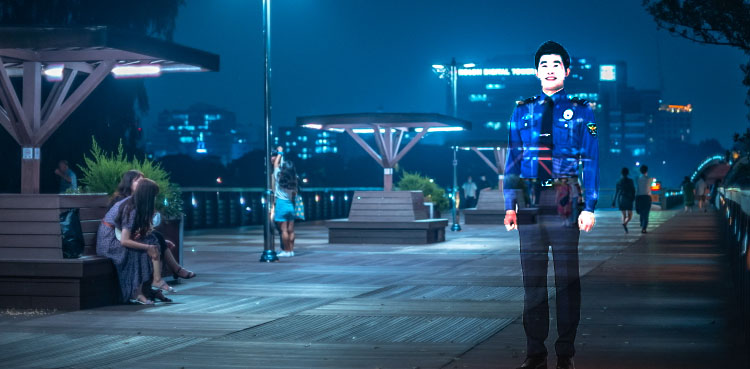
South Korea’s Holographic Police: A Futuristic Approach to Public Safety in Seoul
South Korean authorities now use life-size holographic police officers in Seoul. This groundbreaking deployment marks a significant leap in crime deterrence technology. It introduces a new, highly visible presence in public areas. The innovation aims to enhance security and prevent unlawful activities.
This technology is being implemented to address growing concerns about public safety. Traditional methods may not always be enough in bustling urban settings. Seoul seeks effective, non-traditional ways to combat crime. Public spaces, like parks, are often targets for petty offenses. Holographic officers offer a novel solution to these challenges.
This article explores the advanced technology behind these digital officers. It examines their intended benefits for urban safety. Potential challenges and public reactions will also be discussed. This initiative provides a glimpse into the future of policing and security.
The Technology Behind Seoul’s Holographic Officers
How Holographic Projection Works
Holographic projection creates realistic, three-dimensional images. These images appear to occupy physical space. The technology makes the “officer” seem truly present in a specific location. Specialized projection methods are key to this illusion.
One common technique is the Pepper’s ghost effect. It uses angled glass or a semi-transparent screen. Light from a powerful projector bounces off this surface. This creates the illusion of a solid object. The hardware includes powerful projectors and specialized screens. These are set up to display the officer’s image. All components are carefully hidden to maintain the illusion.
Creating a Lifelike Presence
Great effort goes into making these holographic officers look real. Their goal is to appear as authoritative as possible. This realism helps to deter potential offenders. The officers are designed to wear authentic police uniforms. Every detail, from badges to gear, is precise.
Subtle movements and animations enhance their presence. A slight shift in posture or a slow turn of the head makes them more convincing. While initial deployments are not fully interactive, their lifelike appearance commands attention. This visual presence aims to make people think twice before committing a crime.
Strategic Deployment and Objectives
Targeting High-Traffic Public Spaces
Holographic police officers are placed in specific public areas. These locations are chosen based on reported crime rates. High public use also plays a role in site selection. The aim is to boost security where it is most needed.
Initial deployments focus on public parks in Seoul. These green spaces often see high foot traffic. They can also be spots for minor crimes like littering or vandalism. The selection criteria include crime statistics and visitor volume. Placing the virtual officers in these areas maximizes their deterrent effect.
Primary Goals: Deterrence and Prevention
South Korea’s holographic policing initiative has clear objectives. Its main goal is to deter petty crime and acts of vandalism. The presence of a “police officer” can discourage unlawful behavior. This increases the perceived presence of law enforcement.
The initiative also aims to boost the public’s feeling of safety. Citizens may feel more secure knowing there is a constant police presence. While specific crime rate data is still being gathered, early observations suggest a positive impact on community behavior. The program seeks to create safer environments without needing constant human patrol.
Public and Expert Reactions
Initial Public Perception
The public in Seoul has reacted with a mix of surprise and curiosity. Citizens often pause to observe the holographic police officers. Some report a feeling of increased safety. Others find the concept futuristic and engaging.
One common scenario involves passersby doing a double-take. They quickly realize the officer is a hologram. Despite the initial shock, many express a sense of novelty. This technology encourages a unique form of public engagement with law enforcement. It highlights how visual presence alone can influence behavior.
Law Enforcement and Security Expert Commentary
Law enforcement professionals and security experts have shared varied insights. Many recognize the innovative potential of holographic deterrence. They note its ability to create a constant presence where human officers cannot be all the time. This frees up human resources for more complex tasks.
Experts highlight the cost-effectiveness compared to deploying human officers around the clock. However, they also stress that holograms cannot replace real officers. They serve as a supplement, not a substitute. Most analyses agree that the effectiveness hinges on public perception and technological reliability.
Challenges and Future Potential
Limitations of Holographic Policing
Holographic officers face inherent limitations. They cannot physically intervene in a crime. They cannot apprehend suspects or offer direct assistance. This means they are purely a deterrent and a surveillance aid.
The technology is also vulnerable to vandalism or technical glitches. Any malfunction could undermine their perceived authority. Cost-effectiveness is another point of discussion. While cheaper than human patrols, the initial setup and maintenance costs can be significant. Ethical questions also arise about public trust in non-human law enforcement.
Expanding the Concept: Future Applications
The potential for this technology extends beyond current deployments. Holographic officers could appear in other high-risk public spaces. This includes transport hubs, sports stadiums, or large event venues. They could be integrated with existing surveillance systems. This creates a powerful network for monitoring.
Future developments might include more advanced interactive capabilities. This could involve pre-recorded messages or warnings. Other cities might consider similar pilot programs to test their effectiveness. Such innovations could change how urban spaces are managed for safety and security.
Conclusion
South Korea’s pioneering use of holographic police officers represents a novel approach to public safety. This initiative clearly shows a commitment to leveraging technology for crime deterrence. The core objective remains simple: enhance perceived law enforcement presence to make communities safer.
This innovative step highlights the evolving nature of policing. It demands a careful balance between technological advancements and practical realities. Continued evaluation of public reception and real-world effectiveness will be crucial. The landscape of law enforcement technology continues to advance, promising new ways to impact community safety in the years ahead.



